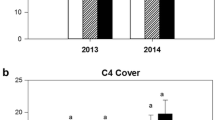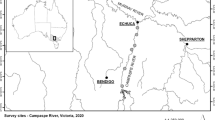Abstract
Saltcedar (Tamarix chinensis) reportedly has altered ecosystem function in many riparian areas of the American Southwest. I investigated the functional role of this exotic species relative to native Fremont cottonwood (Populus fremontii) along the free-flowing middle San Pedro River in southern Arizona. Floodplains in this river reach are co-dominated by young stands of saltcedar (<44 yrs old) and Fremont cottonwood (<67 yrs old). Mean values for 22 of 30 soil, geomorphology, and vegetation structure traits did not differ significantly between saltcedar and Fremont cottonwood stands. Twenty-six of the 30 traits had similar patterns for change over time (infereed from a succession gradient). Saltcedar was functionally equivalent to Fremont cottonwood for about half of the traits construed as indicators of riparian ecosystem function. Several functions or traits that are theoretically or observably influenced by saltcedar on other rivers (e.g., sedimentation rates, electrical conductivity of soils) did not differ between the two species along the San Pedro. This suggests that the functional role of saltcedar is context-specific and variable among rivers. Also in contrast to the working paradigm, saltcedar appeared to enhance the maintenance of floristic biodiversity. Understory herbaceous cover and species richness were significantly greater than in cottonwood stands, perhaps due to soil differences that developed between the two stand types (e.g., higher clay content in saltcedar soils). Stem densities of velvet mesquite (Prosopis velutinu) and other woody successional species did not differ between saltcedar and cottonwood stands. However, stem densities for this group increased with stand age only for cottonwood, raising the possibility that salicedar may disrupt successional pathways. Other notable differences included greater basal area and canopy height in cottonwood stands, and accumulation of more phosphorus in cottonwood soils than in saltcedar soils.
Similar content being viewed by others
Literature Cited
Anderson, B. W. 1989. Research as an integral part of revegetation projects. USDA Forest Service General Technical Report PSW-110:413 419.
Auble, G. T., J. M. Friedman, and M. L. Scott. 1994. Relating riparian vegetation to present and future streamflows. Ecological Applications 4:544–554.
Barrows, C. W. 1993. Tamarisk control. II. A success story Restoration and Management Notes 11:35–38.
Blackburn, W. H., R. W. Knight, and J. L. Schuster. 1982. Saltcedar influence on sedimentation in the Brazos River. Journal of Soil and Water Conservation 37:298–301.
Boggs, K. and T. Weaver. 1994. Changes in vegetation and nutrient pools during riparian succession. Wetlands 14:98–109.
Bower, C. A. and L. V. Wilcox. 1965. Soluble salts. p. 933–951.In C. A. Black (ed.) Methods of Soil Analysis. American Society of Agronomy, Madison, WI. USA.
Brock, J. H. 1994.Tamarix spp. (saltcedar), an invasive exotic woody plant in arid and semi-arid riparian habitats of Western USA. p. 27–44In L. C. de Waal, L. E. Child, P. M. Wade, and J. H. Brock (eds.) Ecology and Management of-Invasive Riverside Plants. John Wiley and Sons Ltd., West Sussex. England.
Brotherson, J. D. and V. Winkel. 1986. Habitat relationships of saltcedar (Tamarix ramosissima) in central Utab. Great Basin Naturalist 46:535–541
Brown, D. E. 1982. Biotic communities of the American Southwest-United States and Mexico. Desert Plants 4:1–342.
Busch, D. E. 1995. Effects of fire on southwestern riparian plant community structure. Southwestern Naturalist 40:259.
Busch, D. E. and S. D. Smith 1995. Mechanisms associated with decline of woody species in riparian ecosystems of the Southwestern U.S. Ecological Monographs 65:347–370.
Busch, D. E. and S. D. Smith 1993. Effects of fire on water and salinity relations of riparian woody taxa. Oecologia 94:186–194.
Carman, D. E. and J. D. Brotherson. 1982. Comparison of sites infested and not infested with saltcedar (Tamarix pentandra) and Russion olive (Elaeagnus angustifolia). Weed Science 30:360–364.
Day, P. R. 1965. Particle fractionation and particle-size analysis. p. 545–568.In C. A. Black (ed.) Methods of Soil Analysis. American Society of Agronomy, Madison, WI, USA.
Decker, J. P. 1961. Salt secretion byTamarix pentandra. Forest Science 7:214–217.
DeLoach, J. 1991. Biological control of weeds in the United States. Natural Areas Journal 11:129–142.
Ellis, L. M. 1997. Rodent communities in native and exotic riparian vegetation in the middle Rio Grande Valley of central New Mexico. Southwestern Naturalist 42:13–19.
Ellis, L. M. 1995. Bird use of saltcedar and cottonwood vegetation in the middle Rio Grande Valley of New Mexico, USA. Journal of Arid Environments 30:77–84.
Glinski, R. L., and R. D. Ohmart. 1984. Factors of reproduction and population densities in the Apache cicada (Diceroprocta apache). Southwestern Naturalist 29:73–79.
Graf, W. L. 1978. Fluvaial adjustments to the spread of tamarisk in the Colorado Plateau region. Geological Society of America Bulletin 89:1491–1501.
Griffin, G. E., D. M. Stafford Smith, S. R. Morton, G. E. Allan, and K. A. Masters. 1989. Status and implications of the invasion of tamarisk (Tamarix aphylla) on the Finke River, Norther Territory, Australia. Journal of Environmental Management 29:297–315.
Harris, D. R. 1966. Recent plant invasions in the arid and semi-arid Southwest of the United States. Annals of the Association of American Geographers 56:408–422.
Horton, J. S. 1977. The development and perpetuation of the permanent tamarisk type in the phreatophyte zone of the Southwest. USDA Forest Service General Technical Report RM-43:124–127.
Hunter, W. C., R. D. Ohmart, and B. W. Anderson. 1988. Use of exotic saltcedar (Tamarix chinensis) by birds in arid riparian systems. Condor 90:113–123.
Johnson, W. C., R. L. Burgess, and W. R. Keammerer. 1976. Forest overstory vegetation and environment on the Missouri River floodplain in North Dakota. Ecological Monographs 46:59–84.
Jackson J., J. T. Ball, and M. R. Rose. 1990. Assessment of the salinity telerance of eight Sonoran Desert riparian trees and shrubs. Desert Research Institute, Reno, NV, USA.
Lehr, J. H. 1978. A Catalogue of the Flora of Arizona. Desert Botanical Garden, Phoenix, AZ, USA.
Li, R. M. and H. S. Shen. 1973. Effects of tall vegetation on flow and sediment. Journal of the Hydraulics Division. American Society of Civil Engineers HY5:793–814.
Pacific Estuarine Research Laboratory (PERL). 1990. A manual for assessing restored and natural coastal wetlands with examples from southern California. California Sea Grant Program. La Jolla. CA, USA.
Parker, I. M. and S. H. Reichard. 1998. Critical issues on invasion biology for conservation science. p. 283–305.In P. L. Fiedler and P. M. Kareiva (eds.) Conservation Biology for the Coming Decade. Chapman Hall, New York, NY, USA.
Robinson, T. W. 1965. Introduction, spread, and arcal extent of saltcedar (Tamarix) in the western states, U.S., Geological Survey Professional Paper 491-A:1–13.
Sala, A., S. D. Smith, and D. D. Devitt. 1996. Water use byTamarix ramosissima and associated phreatophytes in a Mojave Desert floodplain. Ecological Applications 6:888–898.
Scala, J. R. 1984. Recent vegetation changes and their relationship to beach soil dynamics along the Colorado River through Grand Canyon. MS Thesis. University of Virginia. Charlottesville, VA. USA.
Scott, M. L., G. T. Auble, and J. M. Friedmann. 1997. Flood dependency of cottonwood establishment along the Missouri River, Montana, USA. Ecological Applications 7:677–690.
Shafroth, P. M., J. M. Friedman, and I. S. Ischinger. 1995. Effects of salinity on establishment ofPopulas fremontii (cottonwood) andTamarix ramosissima (saltcedar) in Southwestern United States. Great Basin Naturalist 55:58–65.
Siegel, R. S. and J. H. Brock. 1990. Germination requirements of key southwestern woody riparian species. Desert Plants 10:3–8. 34.
Sokal, R. R. and F. J. Rohlf. 1981. Biometry. W. H. Freeman and Company, San Francisco, CA, USA.
Stevens, L. E., J. C. Schmidt, T. J. Ayers, and B. T. Brown, 1994. Flow regulation, geomorphology, and Colorado River marsh development in the Grand Canyon. Arizona. Ecological Applications 5:1025–1039.
Stevens, L. E. 1989. Mechanisms of riparian plant community organization and succession in the Grand Canyon. Arizona. Ph.D. Dissertation. Northern Arizona University, Flagstaff, AZ, USA.
Stromberg, J. C. 1997. Growth and survivorship of Fremont cottonwood, Goodding willow, and salteedar seedlings after large floods in central Arizona. Southwestern Naturalist 57:198–208.
Stromberg, J. C., L. M. Gengarelly, and B. Rogers. 1997. Exotic herbaceous species in Arizona’s riparian ecosystems. p. 45–57.In J. H. Brock, M. Wade, P. Pysek, and D. Green (eds.) Plant Invasions: Studies from North America to Europe. Backhuys Publishers. Leiden, The Netherlands.
Stromberg, J. C., R. Tiller, and B. Richter. 1996. Effects of groundwater decline on riparian vegetation of semiarid regions: the San Pedro River, Arizona, USA. Ecological Applications 6:113–131.
Thomas, H. E. 1963. Causes of depletion of the Pecos River in New Mexico, U.S. Geological Survey Water-Supply Paper 1619-G.
Vitousek, P. M. 1986. Biological invasions and ecosystem properties: can species make a difference? p. 163–176.In H. A. Mooney and J. A. Drake (eds.) Ecology of Biological Invasions of North America and Hawaii. Springer-Verlag, New York, NY, USA.
Westman, W. E. 1990. Park management of exotic plant species. problems and issues. Conservation Biology 4:251–260.
Author information
Authors and Affiliations
Rights and permissions
About this article
Cite this article
Stromberg, J.C. Functional equivalency of saltcedar (Tamarix Chinensis) and fremont cottonwood (Populus fremonth) along a free-flowing river. Wetlands 18, 675–686 (1998). https://doi.org/10.1007/BF03161682
Received:
Revised:
Accepted:
Issue Date:
DOI: https://doi.org/10.1007/BF03161682




